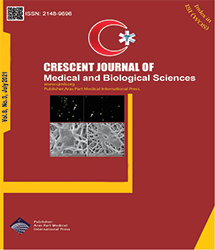
| Original Article | |
| The Effect of Mummy Substance on Matrix Protein Synthesis by Human Adipose-Derived Stem Cells and Dermal Fibroblast and Their Behavior on Plated PCL Scaffold | |
| Sepideh Hassanpour Khodaei1, Leila Roshangar2, Shahnaz Sebetkam3, Jafar Soleimani Rad2 | |
| 1Department of Dentistry, Eastern Mediterranean University Famagusta, North Cyprus, Mersin 10, Turkey 2Stem Cell Research Center, Tabriz University of Medical Sciences, Tabriz, Iran 3Department of Histopathology and Anatomy, Faculty of Medicine, Tabriz Branch, Islamic Azad University, Tabriz, Iran |
|
|
CJMB 2021; 8: 198-204 Viewed : 3710 times Downloaded : 2696 times. Keywords : Mummy substance, Wound healing, Adipose-derived stem cells, Human fetal foreskin fibroblast, Co-culture, Matrix protein, Poly(ε-caprolactone) scaffold, SEM |
|
| Full Text(PDF) | Related Articles | |
| Abstract | |
Objectives: Wounds repair has always been regarded as a challenge in health world due to its high prevalence characteristics. Therefore, there are many proposed therapeutic strategies for repairing wounds in which the use of herbal medicines is highlighted because of the low costs and complications. In traditional medicine, "Mummy" is regarded as almost a first choice for some treatments such as bone fractures, bleeding control, poisoning treatment, headache relief and wound repair. This study seeks to provide a scientific venture for the effect of mummy on wound healing. Materials and Methods: Human fetal foreskin fibroblast cells (HFFF-2) were purchased from Pasteur Institute (Tehran, Iran). The fibroblast cell lines and stem cells derived from adipose-derived stem cells (ASCs) were isolated by means of explant culture. Synthesis of components of extracellular matrix (ECM) such as collagen type I, type III and fibronectin 1 (FN1) were determined by real-time polymerase chain reaction (PCR) and cells attachments were examined by scaffold and cell proliferation determined by MTT assay. ASCs and HFFF-2, were investigated under mono-culture experimental conditions, then the other two-cell co-culture cells were also investigated under laboratory condition with 50-50 and 30-70 ratio respectively. They were all in an experimental group including culture medium and mummy; on the other side, in the control group there were just culture medium. Results: The results suggested that in fibroblasts, the level of mRNA expression of fibronectin was up-regulated in the treatment group (P < 0.0001), it was up-regulated Col type I (P < 0.0001) and Col type III (P<0.01) in ASCs. In co-culture, mRNA expression of Col type I, III, and fibronectin increased (P < 0.0001). The cells were successfully penetrated and adhered, and spread on PCL (polycaprolactone) scaffolds in all groups. Higher proliferation rate of fibroblasts was observed in Mummy-treated cells compared to the control group after 24 hours (P < 0.0001). Increased proliferation rate in ASCs was seeded on scaffolds and treated with mummy compared to control groups for 24 hours (P < 0.01) and 96 hours (P < 0.0001). Proliferation rate in co-cultured ASCs and fibroblasts (proportion of 50-50 and treated with mummy) was higher after 24 hours compared to the control cells (P < 0.0001); but in co-cultured ASCs and fibroblasts, proportion of 70-30 was significantly lower in Mummy–treated group compared to the control group (P < 0.0001) at both lengths of time. Conclusions: mummy may improve wound healing through synthesizing ECM attachment and proliferating cells on PCL scaffold. |
Cite By, Google Scholar
Google Scholar
PubMed
Online Submission System
 CJMB ENDNOTE ® Style
CJMB ENDNOTE ® Style
 Tutorials
Tutorials
 Publication Charge
Medical and Biological Research Center
About Journal
Publication Charge
Medical and Biological Research Center
About Journal
Aras Part Medical International Press Editor-in-Chief
Arash Khaki
Deputy Editor
Zafer Akan


















